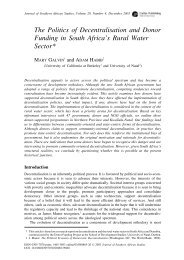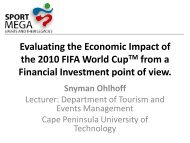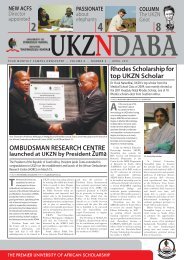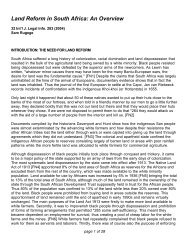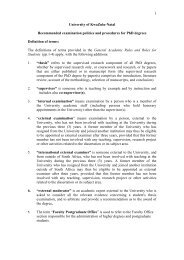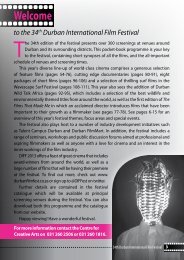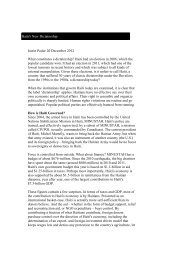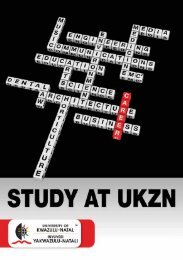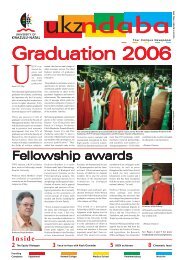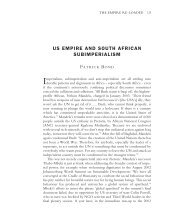Times Higher Education ranks UKZN in the Top 400 Page 3
Times Higher Education ranks UKZN in the Top 400 Page 3
Times Higher Education ranks UKZN in the Top 400 Page 3
You also want an ePaper? Increase the reach of your titles
YUMPU automatically turns print PDFs into web optimized ePapers that Google loves.
12YOUR MONTHLY CAMPUS NEWSPAPER • VOLUME 9 • NUMBER 9 • SEPTEMBER 2012The <strong>UKZN</strong> GriotOf Bulls and BearsKEYAN G TOMASELLIMY column on “Illiterates”drew a response fromJohann Mouton whoseCentre for Research on Evaluation,Science and Technology, regularlycontracts to undertake surveys ofissues on knowledge productionand post-graduate studies <strong>in</strong> <strong>the</strong>tertiary education sector. Ifanybody knows what threats faceuniversities, it is surely he. Johannobserves: ‘We found <strong>in</strong> a recentstudy that <strong>the</strong> results of<strong>in</strong>discrim<strong>in</strong>ate admissions policy at<strong>the</strong> postgraduate level is hav<strong>in</strong>gdisastrous effects.’A few universities that havebeen accept<strong>in</strong>g any doctoralstudent (no selection/ no screen<strong>in</strong>g)have a drop-out rate of 90 percent!‘Just th<strong>in</strong>k of <strong>the</strong> completewaste of faculty time <strong>in</strong> try<strong>in</strong>g tosupervise this cohort where only 10percent eventually graduate. Notsurpris<strong>in</strong>gly, top universities areactually go<strong>in</strong>g <strong>the</strong> o<strong>the</strong>r route andputt<strong>in</strong>g <strong>in</strong> more str<strong>in</strong>gent selectioncriteria at this level’.I like to th<strong>in</strong>k that <strong>UKZN</strong> isfollow<strong>in</strong>g this ‘o<strong>the</strong>r’ route.Johann’s response rem<strong>in</strong>ds meof one of <strong>the</strong> Corollaries ofMurphy’s First Law: ‘It isimpossible to make anyth<strong>in</strong>gfoolproof because fools are so<strong>in</strong>genious’. The <strong>in</strong>geniouscomprise two constituencies <strong>in</strong> <strong>the</strong>academic sector: a) <strong>the</strong> fools whoapply for PhD studies; and b) <strong>the</strong>fools who admit <strong>the</strong>m.The adm<strong>in</strong>istrators who setunrealistic ‘targets’ (for admission)are not <strong>the</strong>mselves responsible forensur<strong>in</strong>g throughput. Thatdaunt<strong>in</strong>g task is allocated to <strong>the</strong>hapless, <strong>in</strong>creas<strong>in</strong>gly underpaid,exhausted academic sector, that isdumped with <strong>the</strong> job of do<strong>in</strong>g <strong>the</strong>impossible amongst all <strong>the</strong> o<strong>the</strong>rimpossible th<strong>in</strong>gs <strong>the</strong>y are expectedto deliver on. If <strong>the</strong>y fail, <strong>the</strong>y are<strong>the</strong> ones who are punished forfail<strong>in</strong>g to achieve <strong>the</strong>ir KPAs, not<strong>the</strong> <strong>in</strong>genious fools who admitted<strong>the</strong> <strong>in</strong>genious applicants <strong>in</strong> <strong>the</strong>first place. As Murphy’s Third Lawstates, ‘Nature always takes sideswith <strong>the</strong> hidden flaw’. Well, nowthat flaw has been exposed byMouton. The fools who admit justanyone to doctoral programmeswork <strong>in</strong> terms of Wozencraft’s Law,‘If you make all of your plans on<strong>the</strong> assumption that a particularth<strong>in</strong>g won’t happen, it will’. So,those <strong>in</strong>stitutions that accept PhDapplicants without screen<strong>in</strong>g butwho expect success have a 90percent drop out rate when <strong>the</strong>yexpect a 90 percent pass rate.Why do educated policy makersand senior management make suchgrievous and obvious errors?These start with <strong>the</strong> way thatuniversities are funded, <strong>the</strong>ir needto pay <strong>the</strong>ir bills, and <strong>the</strong> new<strong>in</strong>strumentalist notion thateducational <strong>in</strong>stitutions are simplyproduction l<strong>in</strong>es that enrol“clients” who are processed via <strong>the</strong>promise of learn<strong>in</strong>g, and pushedout at <strong>the</strong> o<strong>the</strong>r end of <strong>the</strong> factory afew years later, whe<strong>the</strong>r or not <strong>the</strong>yare educated or literate.On graduat<strong>in</strong>g <strong>the</strong> students, <strong>the</strong>university <strong>the</strong>n applies for <strong>the</strong> statedosh now owed to it, but it does notcalculate <strong>the</strong> per item cost ofprocess<strong>in</strong>g <strong>the</strong> f<strong>in</strong>alproduct/client/student. Thisoccurs because universities are notrequired to balance <strong>the</strong>ir budgets.Ra<strong>the</strong>r, <strong>the</strong>y defer debts –sometimes endlessly, and often forideological reasons. The verycostly production l<strong>in</strong>e where 90percent of <strong>the</strong> products disappear<strong>in</strong>to <strong>the</strong> waste b<strong>in</strong> prior to f<strong>in</strong>albenefication, is funded by <strong>the</strong>taxpayer who – as we all know – is abottomless f<strong>in</strong>ancial resource. So,some universities accept illiteratesbecause <strong>the</strong>y pay fees (or are trottedout <strong>in</strong> <strong>the</strong> name of equity) and thusare exploited as a k<strong>in</strong>d of futuresbull market offer<strong>in</strong>g a vicariousdebt security, while <strong>the</strong> real debt,hidden <strong>in</strong> <strong>the</strong> <strong>in</strong>ternal account<strong>in</strong>g,pounds academics <strong>in</strong> <strong>the</strong> face, andseriously disadvantages <strong>the</strong> capable10 percent of PhD students who dopass. And, we all know that <strong>the</strong> Lawof Asymmetrical SupervisoryDistribution ensures that <strong>the</strong> 90percent who will <strong>in</strong>evitably fail willconsume 1000 percent+ of allacademic resources, leav<strong>in</strong>g littleleft over for <strong>the</strong> 10 percent whosimply and successfully get on with<strong>the</strong>ir studies – irrespective ofwhe<strong>the</strong>r or not <strong>the</strong>y get adequatesupervision.The contradictions, of course,are clear. Rud<strong>in</strong>’s Law states that ‘If<strong>the</strong>re is a wrong way to dosometh<strong>in</strong>g, most people will do itevery time’. As a comprehensive<strong>the</strong>ory of mistakes, Rud<strong>in</strong>’s Lawportends worse to come. This formof delusional account<strong>in</strong>g admits<strong>the</strong> ‘proposition that it is entirelypossible to pick up a piece of shit by<strong>the</strong> clean end’. (I cannot referencethis delightful comment as itarrived <strong>in</strong> email <strong>in</strong>box withoutattribution. I do sometimes lovemischievous email.).While <strong>the</strong> academics know what<strong>the</strong> problem is (no screen<strong>in</strong>g,massification, m<strong>in</strong>dlesscorporatisation), management <strong>the</strong>nblames <strong>the</strong> academics for <strong>the</strong> 90percent failure rate. Theypredictably do this by demand<strong>in</strong>greports from academics, usually <strong>in</strong>a highly structured format. Thedesign and issu<strong>in</strong>g of uniformforms becomes uniformlyobsessive, sett<strong>in</strong>g forth a flood ofreports and policy statements,computer runs, new surveillancesoftware, employ<strong>in</strong>g ever moretechnocrats who might know <strong>the</strong>irsoftware (but often <strong>the</strong>y don’t).Usually <strong>the</strong>y don’t know squatabout education. When this ispo<strong>in</strong>ted out to <strong>the</strong>m <strong>the</strong>y retort thatsuch critics ‘are resist<strong>in</strong>gtransformation’. This is <strong>the</strong> FirstLaw of Academic Management.Punish <strong>the</strong> academic sector forproblems not of <strong>the</strong>ir own mak<strong>in</strong>g.The second is Merrett’s Caveat on<strong>the</strong> Pr<strong>in</strong>ciple of Management byDisorientation. Never let <strong>the</strong><strong>in</strong>stitutional sector settle, andcreate <strong>the</strong> impression oftransformation by endless (andoften fruitless) restructur<strong>in</strong>g.<strong>UKZN</strong> has been <strong>in</strong>volved <strong>in</strong>restructur<strong>in</strong>g ever s<strong>in</strong>ce I arrivedhere <strong>in</strong> 1985. It’s like be<strong>in</strong>g on atreadmill that more often than notgoes nowhere. Let’s get <strong>the</strong>operational systems work<strong>in</strong>gproperly before we change <strong>the</strong>structures!That’s why <strong>the</strong> state and someuniversities employ consultantslike Mouton to reveal <strong>the</strong> obvious.The obvious, however, is notobvious when it is so obviouslyobvious. Researchers are able toquantify and reveal <strong>the</strong> obviousbecause those to whom a problemshould be obvious are obviouslypedagogically illiterate.Management’s optimistic belief <strong>in</strong>bull markets is counteracted by <strong>the</strong>pessimistic academic sector’sknowledge of bear markets thatfollow <strong>the</strong> bull. There has to be abalance.Keyan G Tomaselli is Director ofThe Centre for Communication,Media and Society. He’s used totalk<strong>in</strong>g a lot of bull.Disclaimer: The viewsexpressed <strong>in</strong> this columnare <strong>the</strong> author’s own.JOMBA!OPENING NIGHTA SENSATIONALDANCE HITMELISSA MUNGROOTHE Elizabeth Sneddon Theatrewas packed to capacity for <strong>the</strong>open<strong>in</strong>g night of <strong>the</strong> 14th JOMBA!Contemporary Dance Experiencepresented by <strong>UKZN</strong>’s Centre forCreative Arts (CCA) with pr<strong>in</strong>cipalfund<strong>in</strong>g from <strong>the</strong> National LotteryDistribution Trust Fund.The act for <strong>the</strong> night featureddancers from <strong>the</strong> Flatfoot DanceCompany and Ensemble BATIDAwho performed A Spr<strong>in</strong>g (two)matter, which is <strong>the</strong> music and storyof Strav<strong>in</strong>sky’s Rite of Spr<strong>in</strong>g, partof collective memory for dancersand musicians over <strong>the</strong> past 100years.It tells of <strong>the</strong> struggle between<strong>the</strong> positive and <strong>the</strong> negative humanbe<strong>in</strong>g <strong>in</strong> th<strong>in</strong>k<strong>in</strong>g and act<strong>in</strong>g; twoopposites that battle each o<strong>the</strong>r,try<strong>in</strong>g to blend and exist peacefully,or conv<strong>in</strong>c<strong>in</strong>g one ano<strong>the</strong>r to aimfor a better co-existence.Patricia van Deutekom, JuliaWilson, and Lerato Lipere of <strong>the</strong>Flatfoot Dance Companyperformed A Spr<strong>in</strong>g (two) matteron <strong>the</strong> open<strong>in</strong>g night of JOMBA!Produced by <strong>the</strong> Publications Unit, Corporate Relations Division. Tel: 031 260 8737/8370/4249. www.ukzn.ac.za <strong>UKZN</strong>DABA is pr<strong>in</strong>ted on environmentally friendly paper.



